#historical costuming resources
Explore tagged Tumblr posts
Note
Hi I love that area where menswear and womenswear overlap!
You may want to look at Bikes and Bloomers, they have free victorian cycling outfit patterns:
I'm also particularly fond of the Regency military inspired spencers, Laughing Moon and Bernadette Banner have a pattern.
And of course you can't go wrong with a waistcoat. Seconding elfgirlcraftworks for those recs and adding that Waistcoats from the Hopkins Collection is the most beautiful historical waistcoat reference book for men and women (does not contain patterns or instructions though)
Hope this helps!
Have you ever made any masc type garments, think ridding outfits, those eras where small bits of men's wear were popular for women, ect. If you have do you know and good sources for patterns or references?
not really! I've toyed with the idea of making a lady's waistcoat when I was considering a joint 1890s Sarah-From-Labyrinth project with a friend, but it never came to fruition
I don't ride, so I have no use for a riding habit (I prefer to be able to Do Things in my kit) and I live in an area where cycling would be street cycling and I've had two separate friends in bike vs. car hit-and-runs. which does not inspire confidence
I think Truly Victorian might have some patterns in that vein though?
#thanks for reminding me how much i want a riding habit#the lacma one is on my list#historical costuming resources#waistcoatsforall
83 notes
·
View notes
Text
Minoan Kilt
The large, structural skirt worn by Minoan women in art is instantly recognizable, and when I made my own I combined current best guesses with my own personal tastes.

My kilt shape follows the hypothesis laid out by Bernice Jones in her book Ariadne's Threads: The Construction and Significance of Clothes in the Aegean Bronze Age. She describes the shape of that of a labrys, a double-headed axe with apparent ceremonial significance in Ancient Minoan culture. This garment may be depicted in Linear-B logogram *166 + we, we-being the backwards-s-shaped squiggle in the center which identifies the piece as a garment.

See pages 336 and 341 in Marie-Louise B. Nosch, The Textile Logograms in the Linear B Tablets
Actual details on construction and materials below the cut:
Construction:
The top and bottom edges of the kilt are concave, so the sides are longer than the middle. This gives the chevron-shape seen on layered kilts in art. In addition, the curved top half makes the skirt flare out, accommodating the hips and giving more freedom of movement to the legs. My kilt measured from my waist to my anklebone at the longest point, and about 1.5 times around my waist.
I chose to make a flounced kilt, with smaller strips of fabric and trim applied to a large base piece, rather than a tiered kilt, in which multiple kilt shapes of varying length are layered one on top of the other, so you end up wrangling 3 layers of fabric around the waist. The flounced kilt saves fabric and gives you a lot more freedom with whatever trim you might want. Jones' diagram for a flounced kilt is seen below:

Unlike the version in the diagram above, I chose not to attach ties to the garment itself both because the linen I used was very heavy and I was concerned about weight, and also because folding the skirt and securing it with a separate tie worked just fine for my tastes. In total I had four flounces: 2 alternating rows each of fabric and fringe.
The vertical edges of most kilts are left plain, probably representing either the selvage or an edge otherwise finished off to prevent fraying. For my kilt, however, I ended up with a couple inches of self-fringe on either side as I adjusted the fabric to the correct width. At least three examples of kilts with fringed vertical edges are known, all three from the so-called "House of the Ladies" in Akrotiri
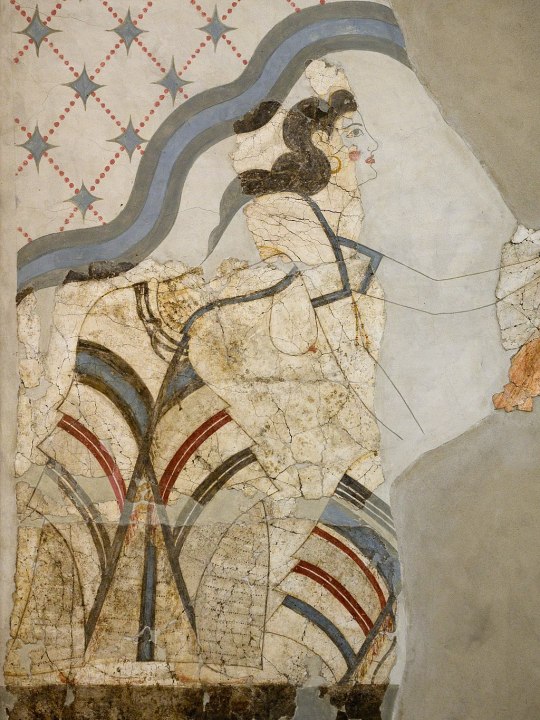

Photos from Wikimedia Commons. Image 1. Image 2.
The vertical edges of these kilts are reinforced with a colored band or tape, probably to keep the garment from unintentional further fraying. Accordingly, I did the same on my kilt. I also like that it gave a nice vertical diagonal to counterbalance the horizontal ones.
Materials
I tried to use mainly linen and wool, the fibers most available on Ancient Crete, but some of my trim was cotton because sometimes you just have to use what's cheap and available in the today times.
The base of my kilt is a heavy, patterned linen in what's called a diaper weave, meaning that a repeating diamond pattern is woven into the pattern itself. A lot of the Minoan textiles depicted in frescoes are characterized by repeating geometric patterns, likely woven into the fabric itself, and that was something I wanted to capture in my own piece. My linen is woven with both cream and natural colored threads. The heavy weight is important to give structure to the garment--otherwise it would be kind of limp. My linen was from Burnley & Trowbridge (shameless plug), as was the plain cotton twill tape I used to bind the top and bottom edges of the kilt, and the dark red wool twill tape I used along the vertical edges.

I bought my cotton fringe from a rug supply store. I had to search a while to find a fringe that would work for me, and I ultimately chose fringes with a woven header rather than the more common knotted one, so that it would lay flat against the kilt. I hid the woven header under a layer of cotton fringed trim from Michaels (yes, Michaels) with this really great diamond and dots pattern woven in black.
The blue layers are from a bolt of vintage wool Kimono fabric. Blue appears frequently in frescoes, likely achieved with indigo or woad dye, or even murex/mollusk dye. The fabric is printed with an imitation ikat pattern of diamonds and squares that made me think "the vibes seem right!" because quite frankly, you aren't going to get "historically accurate" Minoan textiles (which there probably isn't enough archaeological evidence to definitively describe) without, like, hand-weaving it yourself or paying someone hundreds of dollars to do it for you (and that price is if the weaver really likes you). Neither of which appealed to my desire to just make a fun, low stress project. Good enough is good enough.
The narrow trim on the bottom of the blue flounces is vintage cotton/poly woven trim. This trim, while narrow, was quite thick and stiff, which was great because it added more weight and structure to the end of my flounces since the wool fabric itself was quite thin.
The top layer is a custom tablet-woven wool trim that I commissioned from MAHTAVAhandicraft on Etsy. I imagined this as the "centerpiece" of my kilt, and I'd arrange everything to complement it.
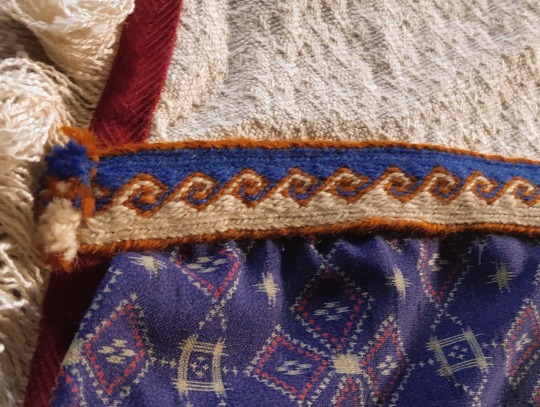
It's a kivrim pattern, which has itself only been traced to 19th-century Anatolia, but I didn't care. The way it looks like waves reminded me of how central the sea was to life in the Ancient Aegean and Mediterranean and it captured the idea and aesthetic I was pursuing. I mean, doesn't it remind you of these dolphins?
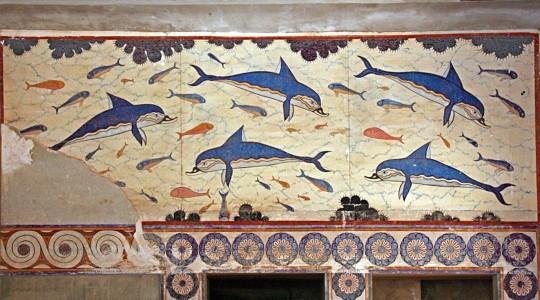
(I like the dolphins)
The whole thing was machine sewn with the exception of hemming and adding trim to the blue flounces. If you were to look at it from the back, you'd see lots of zigzag stitches, because i wanted to be fast! and have fun! not chase some unreachable ideal of "accurate."
As for wearing it, I chose to wear it with the top part folded/rolled down over a belt, so I have a thick tube of fabric around my waist. Many images, like the frescoes above of women with fringed kilts, appear to just show the kilt being tied closed. Other images are so fragmented or stylized that it's unclear what kind of skirt closure was used. Sculptures and figurines definitely show some kind of SOMETHING around the waist, whether this is folded fabric or a kind of belt is unclear. Different art could show different things!
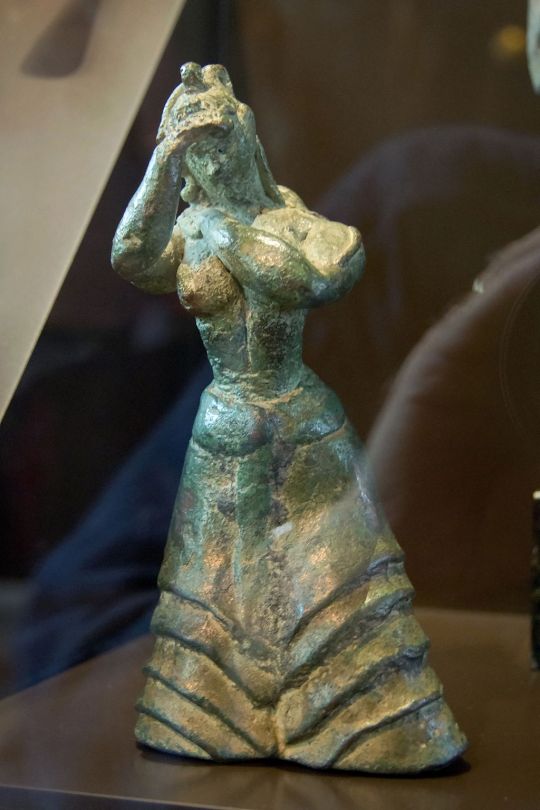
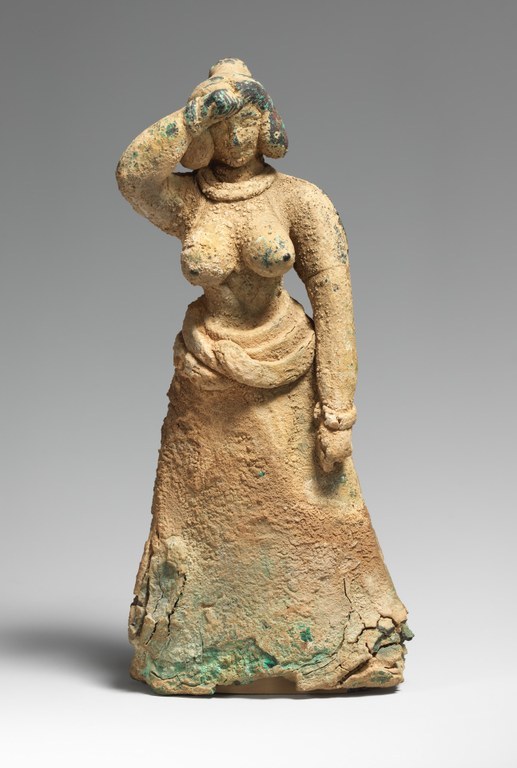
I think I see evidence of a continuous line from the skirt to the waist-roll on the figure on the left, found in Troas, which I think indicates some kind of skirt-folding situation. The woman on the right, found in Crete, looks more like she's wearing some kind of long coiled belt, or perhaps snakes. Who knows? I don't! For my own part, I found the combination of rolled waist + tie belt the most secure for doing things like kneeling, stomping around, and wading into rivers to rescue bees. I also liked that it gave me the bulk around the hips that gives Minoan figurines such a powerful silhouette, and proportionally gives more of an hourglass shape. If you wanted to do something more firmly grounded in the sources, stick just with the waist tie or belt, wrapped around a couple times and tied in back. If you want to be like me, just say "well we don't KNOW it didn't happen" and just do whatever you want. Have fun! Whatever happens, it should be fairly easy to move around in the kilt--this is not a restrictive garment, just a heavy one.
871 notes
·
View notes
Text
░ ✧ ALISHA BOE in THE BUCCANEERS (2023)
GIF PACK • By clicking the source link, you'll find a page containing 250 gifs of norwegian actress Alisha Boe, in the show The Buccaneers (2023), from season 1. They were made by me, and can be used (creditless) for roleplays & similar personal uses, and (credited) in posted works such as edits/video edits. I don't care what themes you're using them for or if they're "problematic" so long as you're not hurting anyone.If you use this gifpack, please like and/or reblog this post, thank you! Content Warnings • Childbirth, alcohol.




Buy me a ☕?
#viscardi gifpacks#alisha boe#the buccaneers#conchita closson#period drama#costume drama#historical drama#gif hunt#gif pack#gif set#rph resources#rp resources#rp help#rph#indie rph#rph br
54 notes
·
View notes
Note
Do you have recommendations for dress history youtube channels? I'm a very bookish person, an amateur historian of literature, and i want to understand the practical side of how clothes were made and worn. the pictures in my books only go so far.
Sure! There's some books that also go into the historical construction of clothing, most notably Janet Arnold's Patterns of Fashion series, which is an invaluable resource. Here's my most recommended YouTube channels who do historical costuming and talk about dress history in general:
Nicole Rudolph Abby Cox Morgan Donner Cat's Costumery Snappy Dragon Bernadette Banner priorattire Adelaine Beeman-White Karolina Żebrowska Samantha Bullat
106 notes
·
View notes
Text
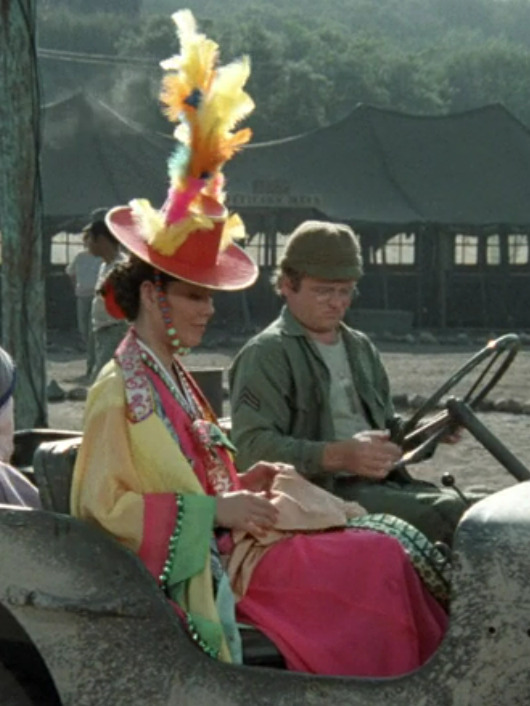

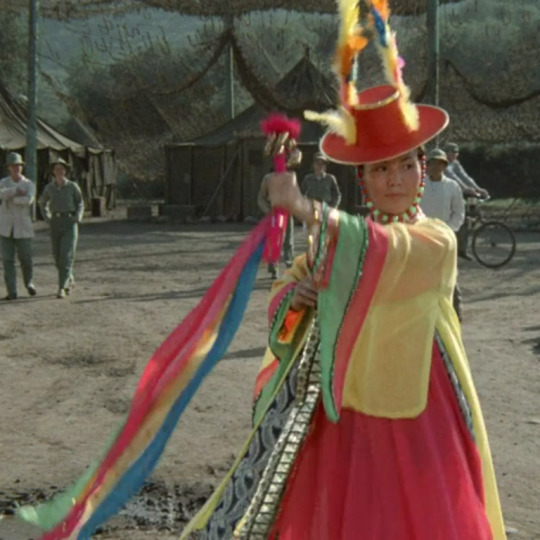

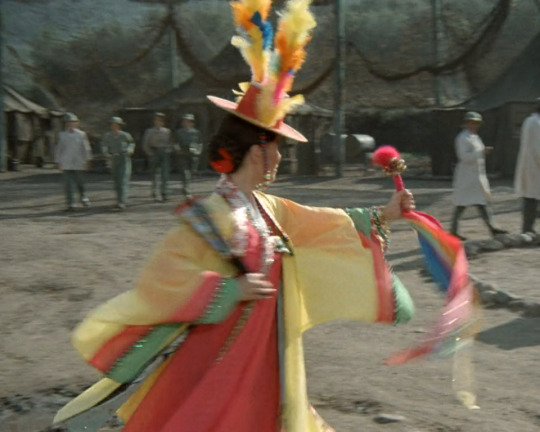
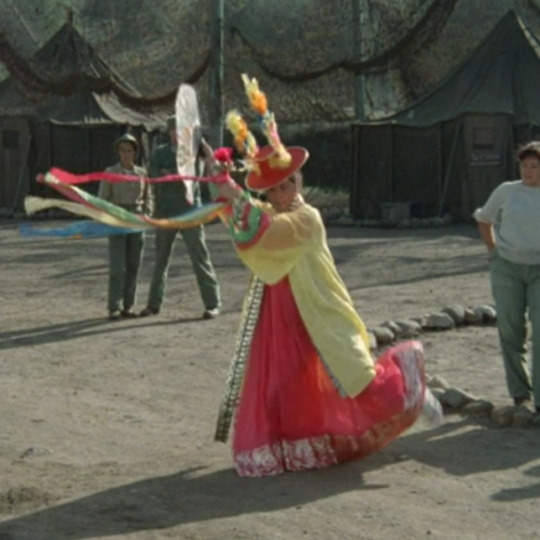
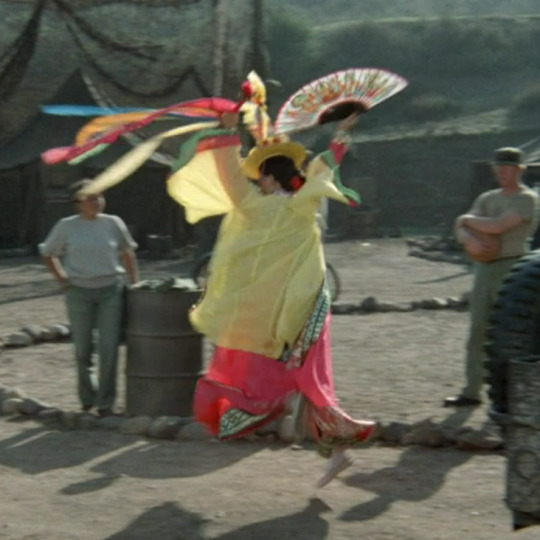

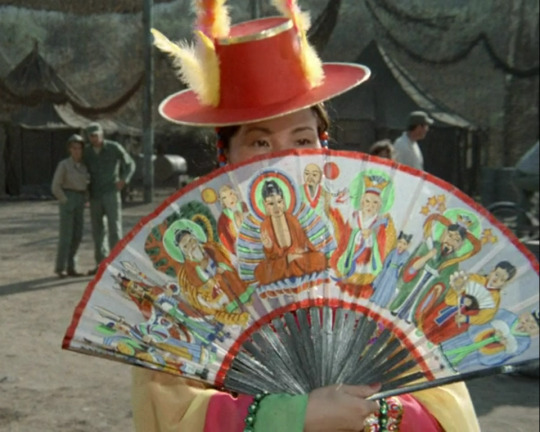

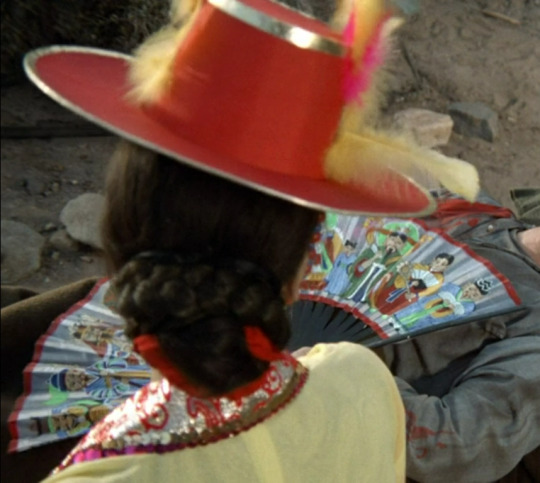
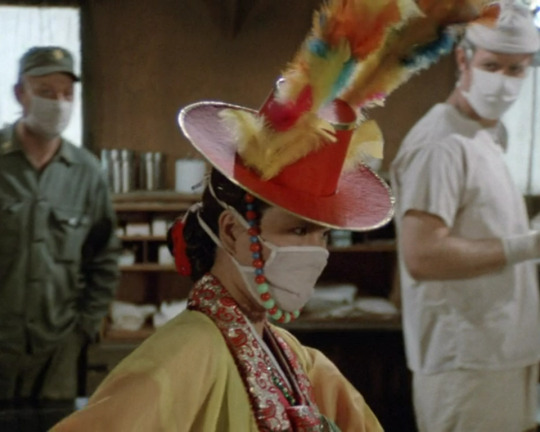
special: korean shaman from season 5 episode 13 "exorcism"
#i couldn't not post this one#her dress is so stunning and i love the way she dances in it#this is one of my favorite episodes for sure#according to mash wiki her clothing and dances are entirely authentic#i don't have the knowledge to confirm that but i love how respectful the episode feel towards the natives and their tradition#i love how the scene with her dancing goes on for so long and really lets it breathe#such a beautiful scene <3#by the way if anyone has resources (online/literature/whatever) about the local clothing and tradition i'd be excited about anything!#will forever hate that our historical costuming classes only cover europe#have a great day everybody#mash#m*a*s*h#klingerfashionarchive#mashblr
30 notes
·
View notes
Text
can anyone suggest any good resources for historial fashion?
update: thanks everyone <3 super helpful
#specifically looking for stuff in the 1860s-1880s range#though currently all my historical costuming books are back in the uk so it'd be great to have some online resources in general#i know in my heart that the gay people in my phone won't let me down
36 notes
·
View notes
Text
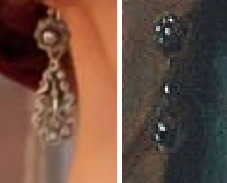
The resolution isn't the best, but to the left is my ear, wearing my favourite pair of antique earrings, and to the left that of a lady of the early 18th century wearing earrings of a very similar design.
I was quite surprised to happen across earrings very much like mine in a painting, despite having seen photos of other currently extant pairs that look very similar online.
Perhaps it is the fact that she selected these exact earrings to be represented in her portrait, similar to me deciding that I wanted my picture taken wearing mine.
#i mainly buy antique jewellery bc they don't require new resources to be produced and bc they're of a more durable quality#even the costume jewellery of the 1910s will last longer than the costume jewellery of today#r rambles#historical jewelry#antique jewellery#18th century#18th century fashion#fashion history
21 notes
·
View notes
Text
I've collected over 150 videos featuring antique and vintage garments (as well as some more modern pieces that use older techniques) into this playlist, ordered in the playlist from oldest posted to newest posted. Though most of the videos are private collectors showing parts of their collection, I've also included lectures on garments like the Lengberg Bra and a couple of videos talking about the history of a few garments alongside showing details.
If anyone knows of any other videos (must be in the form of a youtube video or short), let me know and I'll add them to the playlist! I'm also putting together a list of other resources - blog posts, museum/gallery websites, non-youtube videos, etc. that can helpful to people looking at historic (and vintage) clothing.
#historical clothing#historical fashion#victorian fashion#historical costuming#resource#victorianclothing
3 notes
·
View notes
Text
The MET has a costume institute with a lot of stuff from the 15th century onward AND it's got an online archive with pictures you can look at for free!!! Granted it's all on mannequins but it's all authentic pieces. There aren't a lot of stuff from the Middle East or Africa, so if I find a good resource for those I'll post it too, but I found this and thought you friends might like to know about it too.
10 notes
·
View notes
Text

Folkwear Patterns
"Folkwear provides sewing patterns that are based on authentic vintage and folk garments from around the world. Our patterns are flexible enough to be used for historical and theatrical costuming as well as for making unique every-day-wear. " (Folkwear.com). This resource is a way for those new to patterning of these garments to get an easy start. They feature patterns from around the world that they base on real garments. In addition to patterns they offer sewing supplies and fabric, but the real focus of the addition of this resource is their patterns. The patterns come in pdf or paper format, noting the sizes on the pattern's web page, the suggested fabrics, and a small description of the garment. This resource in connection with one's own research makes this particularly helpful to the beginner to intermediate seamstress.
0 notes
Note
I'm starting to question how much the "old" pagan costumes and festivities were indeed about fertility, sex, etc.
Ronald Hutton claims that there is no evidence in history that the maypole was saw as a phallic symbol, for example. And there are other possible meanings. But you usually just read in books as a matter of fact that it was a phalic representation and the dance around was about fertility etc
I recently read the witche's bible because I was curious about traditional wicca rituals and there is suuch a high focus on how every single costume or holiday was about fertility and sex that honestly it makes me wonder, how much it was indeed about those things and how much is just the interpretation of modern people like Gardner making it about those things
You're hitting the nail on the head without even realizing it, Anon.
SO much of what we think we know about "old pagan customs" comes from books written by Victorian-era occultists. And if there is one thing to be said about Victorian-era occultists, it was that they were horny as FUCK. (And the Edwardians weren't any better.)
These people went around rubber-stamping FERTILITY in big red letters on anything to do with goddesses or springtime or even the most passing reference to pregnancy, childbirth, midwifery, or babies. Literally any excuse for ritual nudity or a sacred orgy. And no, that is not satire. Or a euphemism.
The other thing that can be said about Victorian-era occultists is that quite a lot of them were history buffs and very prolific writers. (If you look at the roster of the Hermetic Order of the Golden Dawn and their regular guests, it reads like a Who's Who of the writers of fantastical fiction and poetry at the time.) So the result of that is a whole lot of literature about folklore and "ancient pagan customs" written by people who were filtering what little historical information they had at the time through the lens of their own opinions and those of their colleagues.
(It's worth noting that that "lens" often consisted quite heavily of free-associated ideas not supported by history or things they completely pulled out of their own asses. Leland's "Aradia" is a good example of the "Ancient Sacred Text Given To Me By A Real Witch Who Totally Exists And I Definitely Didn't Write This Myself And Make Up This Claim For Clout" genre.)
Quite unsurprisingly, a lot of these beliefs got absorbed into the roots of the modern witchcraft movement a few decades later, since those were the popular resources available at the time and the same generally-prevailing opinions and biases were still present. So this started WELL before Gardner and his coven were on the scene. They just picked up the thread.
And as we all know, once there's a generation or so of removal from the founding beliefs of a movement, people tend to take the older texts as gospel, regardless of how flawed they might be.
See Also: We Still Have To Talk About The Witch-Cult Hypothesis Because Margaret Murray Wrote The Encyclopedia Britannica Entry On Witchcraft And It Wasn't Updated Until The 1960s.
See Also: We Still Have To Explain The Difference Between Historical Fiction And The Historical Record Because Of The White Goddess And The Mists Of Avalon.
See Also: We Still Have To Talk About The Burning Times Myth Because Raymond Buckland Made That Stupid Fucking Documentary.
See Also: Why The Hell Is Anyone Still Recommending Silver Ravenwolf.
Anyway, the short answer is that yes, your impression is correct, and I'm glad you're reading Hutton and forming that practical context for the witchcraft/pagan literature and media that you encounter.
Keep honing that bullshit detector and best of luck!
#A. Nonymousse#witchcraft#witchblr#history of witchcraft#pagan#pagan problems#Bree answers your inquiries
405 notes
·
View notes
Text
Minoan Heanos
The distinctive open-front dresses worn by Minoan women are probably even more iconic than the multi-layered kilts. Over time, there's dispute whether the garment is one piece or a separate bodice and skirt, but currently the one-piece theory is in ascendance.

The word heanos is derived from the Linear B logogram *146, wehanos. The wes- prefix, which is the squiggle in the middle, indicates a garment. Bernice Jones believes that this logogram represents the garment worn by Minoan men and women.
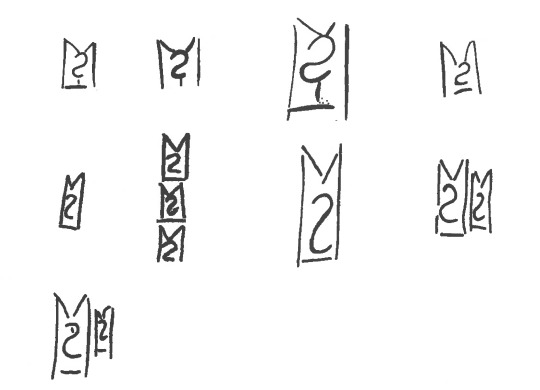
Marie-Louise B. Nosch, The Textile Logograms in the Linear B Tablets, pp 133-138
More research and construction below the cut:
The theory that the garment is a full-length tunic is further supported from imagery from the time, like these figures from the c. 1400 BCE Hagia Triada Sarcophagus. This detail from the sarcophagus shows three figures in some kind of procession, 2 women and 1 man. The woman at left wears a tunic with some kind of pelt as a skirt, and the other 2 figures wear tunics without anything over them, showing that they are one continuous, ankle-length garment.
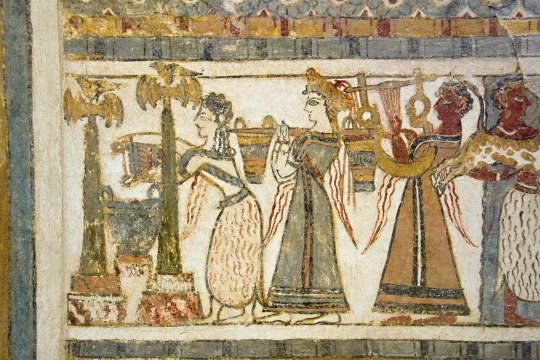
Some of the most important resources for interpreting how the heanos was constructed comes from the two women depicted in the House of the Ladies in Akrotiri, wherein the side seams of the tunic are clearly visible running along the side of the body and under the arm.
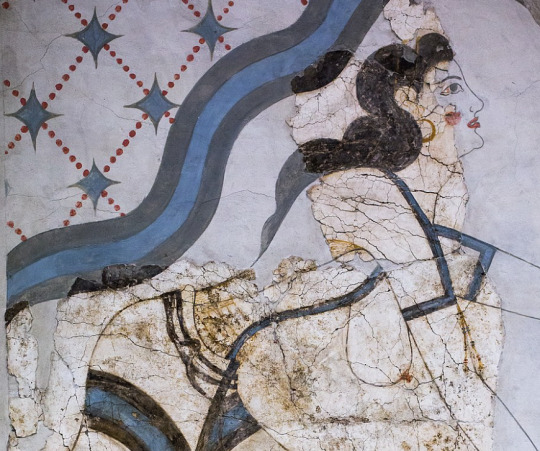
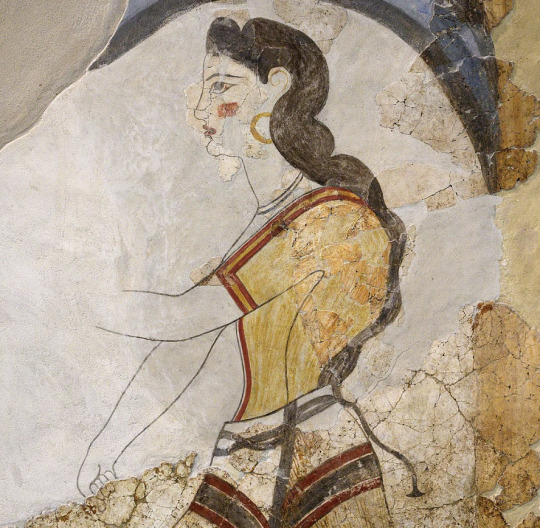
details of figures from the House of the Ladies, Akrotiri, via Wikimedia Commons
advadbsvasb
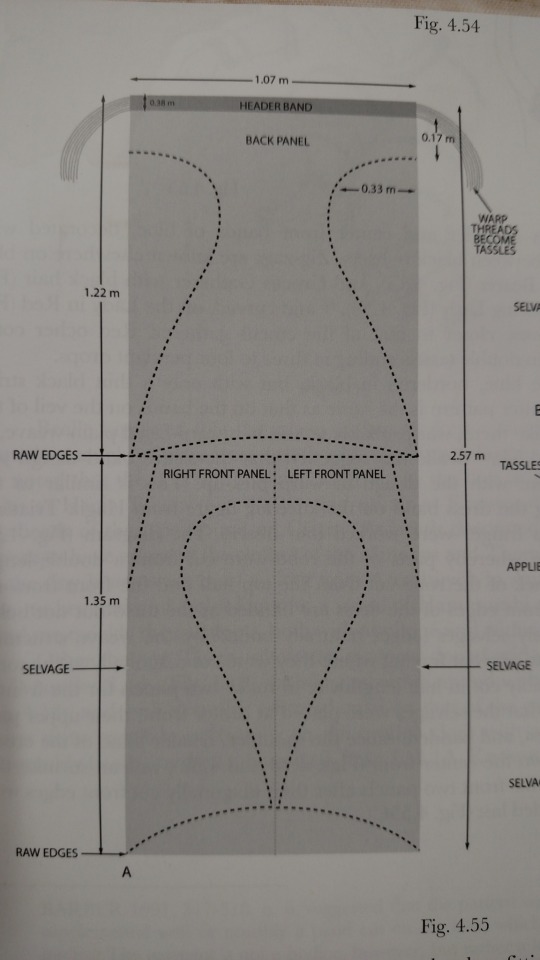

Diagrams from Bernice Jones' book Ariadne's Threads, p. 82, via Gorgeous Tangents
The heanos itself is made of 3 pieces of fabric: 1 back and 2 fronts. These diagrams show a concave hem like on the labrys-shaped kilt but I went with a straight hem, which is an equally valid option. The end of the sleeves are level with the edge of the hem at the widest point. This would probably be the width selvage-to-selvage on the fabric, being narrower than fabric widths commonly are today. There are 4 seams: the shoulder seam, the two side seams, and a front seam (optional, but recommended if you would prefer not being arrested.) It may be tempting to fold the fabric across the shoulder, so the only sewing is side seams and a neck hole, but this makes a weaker garment overall. I used this as a shortcut in my fitting muslin and it caused tears and weak points at the three points of the front opening.

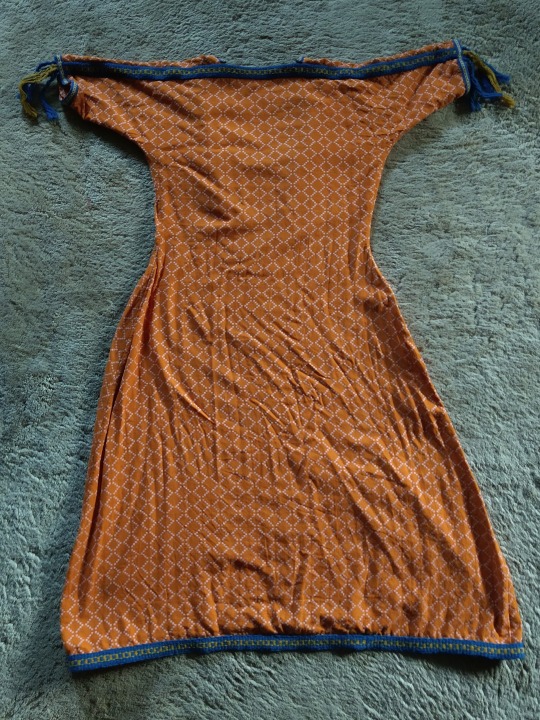
my fabric was a lightweight, moderately loose-woven cotton with a supplementary weave pattern in squares and diamonds. Linen or wool would have been more accurate but also? much harder to find from online quilting stores selling fabric for affordable prices. The main fabric is dark orange and the pattern is made out of pink/lilac threads. This weaving technique resulted in a LOT of long floats (unsecured expenses of thread) on the back--you can see how the wrong side of the fabric is much pinker than the right side. These floats could snag easily if I wasn't careful, so while it made a very effective visual for this tunic, I do not think that this fabric type would be viable for everyday wear. I'll leave it to people who actually know about weaving to ponder what more accurate weaving techniques would be.
Construction
The overall pattern is basically a T-shaped tunic, and the most important measurements are shoulder circumference, shoulder width, bust circumference, and the shoulder-waist length. In addition, you need measurements for the bicep, waist, shoulder-navel length, and hip circumference. After working out the fit with a muslin, I ended up with this pattern, 1 of 4 identical quarters.

Your first impulse may be to make the tunic very close-fitting, since the depictions in frescoes are skin-tight, but since the pattern has no added gusset this is a recipe for Cannot Move Arm. So I gave a very generous curve under the arm, which also made the dress look better when my arms were down, avoiding armpit wrinkles. I continued that ease into about an extra 2 inches added on to my waist measurement and plenty of extra space around my hips so that I could do exciting things like Sit Down.

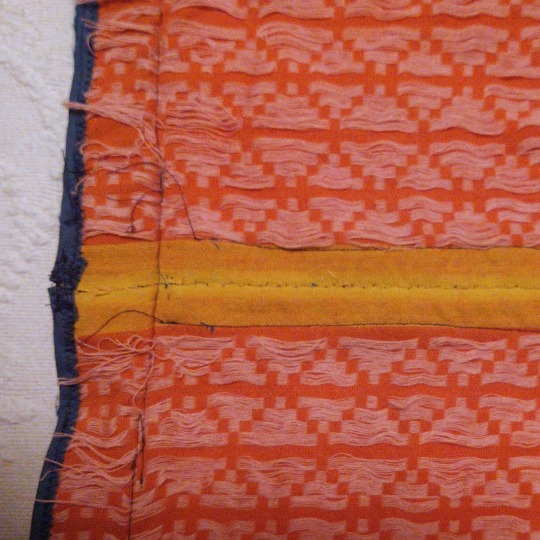
I sewed the shoulder and side seams using the machine, and felled the raw edges on each side of the seam by hand with a whipstitch. I foided back the front edges of the v-neck instead of cutting them, which was a tip I got from the Gorgeous Tangents blog. This strengthens the neckline and keeps it from stretching, and also means that everything can be readjusted if you have size fluctuations or just want to modify the tunic into something more or less modest.
I whipstitched the front edges together by hand--the contrasting selvage didn't matter because it would be covered up by trim. I ended up cutting the tunic a liiiittle shorter than I wanted, so I finished it with some leftover bias binding instead of hemming it to conserve as much length as possible.
Trim
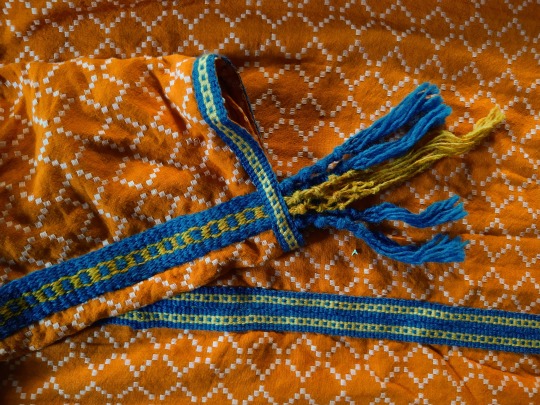
I custom-ordered the woven tape trim from Long Creek Mercantile. Both are made of wool--the "header band" and the hem trim are 1 1/4" wide and the center-front and cuff trim are 3/8" wide. I observed that most images of the Minoan heanos show trim with two colors at most, in a simple geometric or linear pattern, so I consciously restrained myself from ordering anything more elaborate. The clothing on Minoan frescoes is characterized by strongly contrasting colors, so blue trim was the most obvious, and best-looking option. Orange tunics with blue trim appear multiple time in art like the "Dancing Lady" fresco from Knossos:
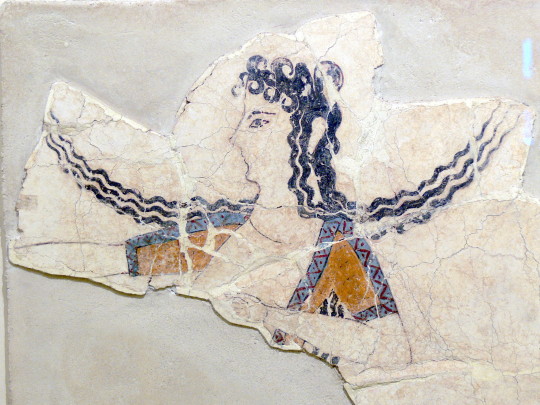
Dr. Jones suggests that the band across the shoulder would historically have been a header band--a band of threads woven at the beginning of a project in order to properly space the warp bands (see her diagram at the beginning). That may be a reason why the shoulder trim often depicted under the front or sleeve trim, as shown above. Regardless, the trim almost always coordinates.
I sewed on the shoulder trim by hand, the sleeve and hem trim by machine, and the center-front trim with a combination of both.
Tassels
Many frescoes from Akrotiri and Hagia Triada show the ends of the supposed header band turned into tassels. This embellishment is not universal among heanoi, as you can see from the "Dancing Lady" above, but it does add a fun little something!
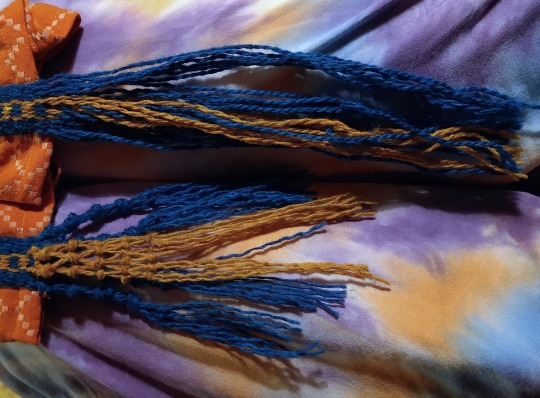
(yes, my Lounging Pants are very fashionable)
I turned the excess ends of the shoulder "header band" trim into fringes, knotting the yellow ones into a lattice and turning the blue yarns into tassels. The lattice-tassel appears on a fresco from Hagia Triada:
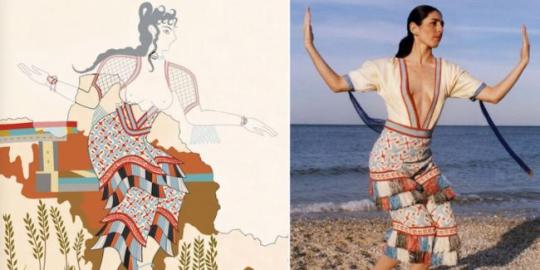
Reproduction of fragmentary fresco from Room 14 at Hagia Triada, Crete
The saffron gatherers from Akrotiri shown below have clearly displayed fringes at the ends of their sleeves. The one on the left has red fringes that appear knotted or ravelled/unravelled in an undulating pattern, and the one on the right has fringes that may be either beaded with papyrus-shaped leaves or cut into short tassels.
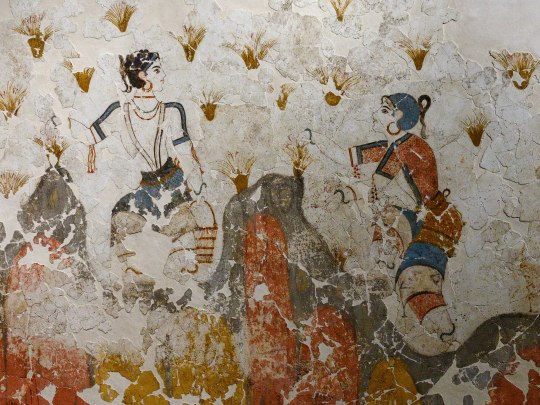
Another option is leaving the fringes loose, as seen in the Akrotiri frescoes from Xeste, room 3:
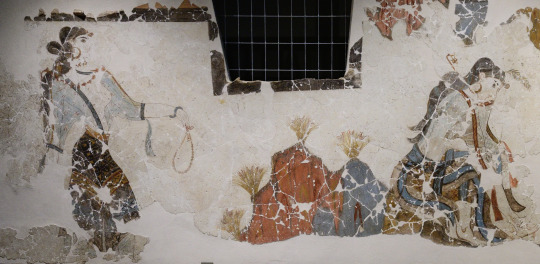
The final garment was super comfy, actually! It's much simpler to create than I thought it would be based on the frescoes, which made it all feel pretty magical when everything came together. I did think it was a little unusual how tailored this garment is, and the potential waste of fabric that comes from a shaped garment, especially compared to how later ancient greek clothing was mainly rectangles. I don't know enough about bronze-age and earlier clothing to have any idea how typical this was, since I'm extremely Not an expert on this subject, but am always open to learning more!
515 notes
·
View notes
Text
░ ✧ AUBRI IBRAG in THE BUCCANEERS (2023)
GIF PACK • By clicking the source link, you'll find a page containing 281 gifs of australian actress Aubri Ibrag, in the show The Buccaneers (2023), from season 1. They were made by me, and can be used (creditless) for roleplays & similar personal uses, and (credited) in posted works such as edits/video edits. I don't care what themes you're using them for or if they're "problematic" so long as you're not hurting anyone.If you use this gifpack, please like and/or reblog this post, thank you! Content Warnings • Nudity, psychological violence.




Buy me a ☕?
#viscardi gifpacks#aubri ibrag#the buccaneers#lizzy elmsworth#period drama#costume drama#historical drama#gif pack#gif hunt#gif set#rp help#rp resources#rph#rph resources#indie rph#rph br
38 notes
·
View notes
Text









The opening scene of Elia Suleiman's Divine Intervention (2002 🇵🇸)
Just as the settlers steal the land from the Palestinians, and claim that it was always theirs… so too does capitalism extricate the political, social, and historical realities from that land and the holiday associated with it. A Santa Claus costume is indeed the garb of a settler. He is colonizing the mind of the world, utilizing the resources he finds most useful and erasing the narratives he finds politically inconvenient. From this uncomfortable equation, we get our opening images of the film. Something familiar: a group of children chasing Santa Claus. But they are not after his presents. They are after him. Moreover, they are after the narrative he has co-opted. He needs to be extinguished so they can make an attempt at reclaiming their history, their culture, and their land. xx
#elia suleiman#remembered this and revisited heh#divine intervention#divine intervention 2002#santa claus#palestinian cinema#dailyworldcinema#filmgifs#filmedit#gifs#moviegifs#why did this take 2 hours...#christmas#akajustmerry#shesnake#albertserra#userhayao
461 notes
·
View notes
Note
Hi! I have to source historical reproductions pretty regularly and the following are a few I've found reputable and good quality for menswear (mixed US and UK sources):
Mid 20th century: Revival Vintage (good quality, but affordable) Chester Cordite (WHOO MAMA SPENDY but worth it)
Georgian/Regency: Fugawee, Jas Townsend & Sons, Darcy Clothing
Victorian: Darcy Clothing, Historical Emporium (the latter is more affordable/mass produced feeling, so check fiber contents of each product individually, and the cuts of their coats are a little modernized at times, but I LOVE their high waisted men's pants and their pintucked shirts. Really lovely. Also note that their collared shirts err 1/2 to a full inch larger than the suggested measurement, so for a period fit with a tie, go down a size)
Good luck, happy shopping!
Do you have any suggestions on where to purchase vintage/reproduction/historically inspired menswear? This is often the first question I get when people find out I went to school for costume design, at which point I am forced to explain that my training... really does not cover that. At all. The shops I'm aware of make either costumes, or exclusively women's clothing, which seems rather unfair.
I'm tempted to just make some, but my program taught exclusively design and no construction. The end result is that I know exactly how a garment is made in theory, but in reality I'm still figuring out waistbands and closures.
I'm afraid I haven't a clue! I don't really buy clothes, aside from socks, shoes, and underwear. But I'll post this and maybe some of my followers will have suggestions.
It sucks that your program didn't teach sewing :( It's so important to have experience putting things together when you have to design those things.
(If you do want to make some, here's an obligatory link to my 18th century menswear resources post.)
178 notes
·
View notes